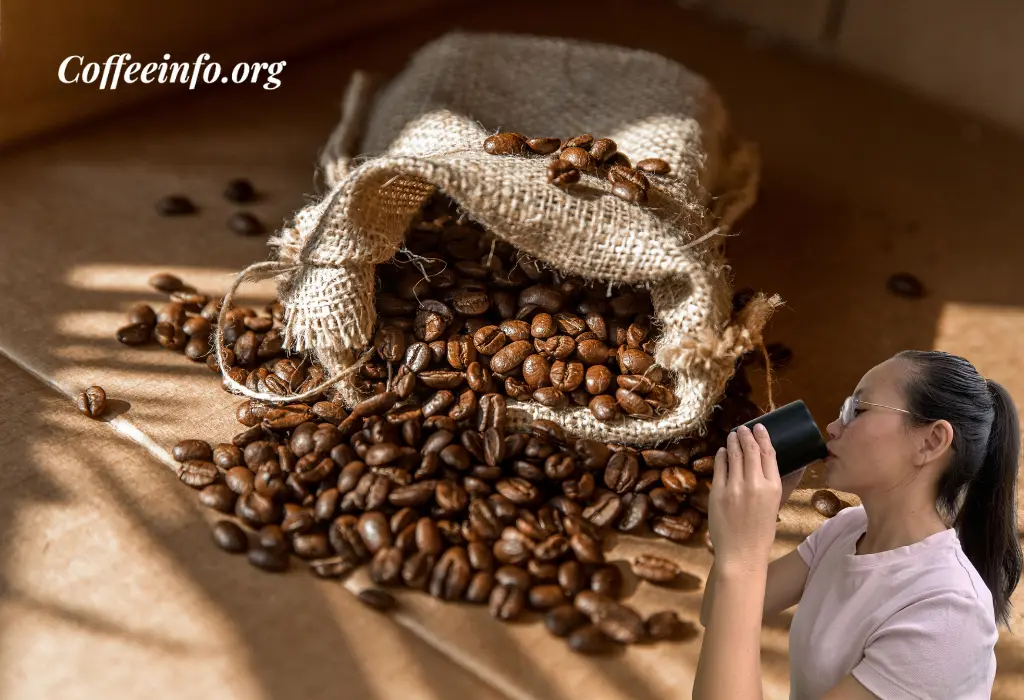What are the top 50 facts about coffee? Coffee is the world’s second-most traded commodity after oil, with over 2.25 billion cups consumed daily worldwide. From its ancient origins in Ethiopia to modern specialty brewing methods, coffee encompasses fascinating trivia about its cultivation, health effects, cultural significance, and economic impact. These facts span coffee history, bean varieties, brewing techniques, consumption patterns, and surprising connections to art, science, and global commerce that make this beloved beverage one of humanity’s most influential discoveries.
Table of Contents
What is Coffee?
Coffee is more than just a morning ritual—it’s a global phenomenon that has shaped cultures, economies, and daily routines for centuries. Whether you’re a casual coffee drinker or a dedicated enthusiast, the world of coffee is filled with surprising stories, fascinating science, and incredible trivia that will deepen your appreciation for every cup.
This comprehensive collection of coffee facts will take you on a journey through coffee history, reveal surprising coffee trivia, and provide essential coffee knowledge for beginners and experts alike. From the mountains of the Philippines to the bustling cafes of major cities, coffee’s influence reaches every corner of our world.
Historical Coffee Facts
1. Coffee originated in Ethiopia around the 9th century. According to legend, a goat herder named Kaldi discovered coffee when he noticed his goats becoming energetic after eating certain berries. This fun fact about coffee history shows how accidental discoveries can change the world. Archaeological evidence supports Ethiopia as coffee’s birthplace, making it the starting point of our global coffee culture.
2. The first coffeehouse opened in Mecca in the early 16th century. These early coffee houses became centers of intellectual discussion and social gathering. Coffee history reveals that these establishments were sometimes called “schools of the wise” because of the stimulating conversations that took place there. This tradition of coffee houses as social hubs continues today worldwide.
3. Coffee reached Europe through Venetian merchants in the 1600s. Initially, some European clergy called coffee “Satan’s drink” until Pope Clement VIII blessed it. This amusing piece of coffee trivia shows how cultural acceptance of new foods and beverages can face religious opposition. The papal blessing helped coffee gain widespread acceptance throughout Christian Europe.
4. The Boston Tea Party indirectly made coffee America’s preferred beverage. After the 1773 protest against British tea taxes, drinking coffee became a patriotic act in America. This fun fact about coffee history demonstrates how political events can shift entire cultural preferences. Coffee consumption in America surged as tea became associated with British oppression.
5. Instant coffee was invented in 1901 by Japanese scientist Satori Kato. While instant coffee faced initial skepticism, it became essential during both World Wars for soldiers. This coffee trivia shows how necessity drives innovation in food technology. Today, instant coffee represents about 15% of global coffee consumption despite purists’ preferences for fresh-brewed varieties.
Coffee Bean Facts
6. There are over 120 species of coffee plants, but only two are commercially significant. Coffea arabica accounts for about 60-70% of global production, while Coffea robusta makes up most of the remainder. Fun facts about coffee beans reveal that arabica is considered superior in flavor but is more difficult to grow. Robusta contains nearly twice the caffeine content of arabica, making it popular for espresso blends.
7. Coffee beans are actually seeds, not beans. These seeds grow inside coffee cherries, which are fruits that turn red when ripe. This surprising coffee trivia often confuses beginners who assume coffee grows as beans. Each coffee cherry typically contains two seeds (beans) facing each other, though occasionally a single round bean called a “peaberry” forms.
8. A single coffee tree produces only 1-2 pounds of roasted coffee per year. This explains why quality coffee commands higher prices than mass-market varieties. Fun facts about coffee beans include that trees don’t reach full production until they’re 3-5 years old. Premium coffee often comes from trees grown at higher altitudes where cooler temperatures slow cherry development, concentrating flavors.
9. Green coffee beans can be stored for years, but roasted beans lose freshness quickly. Properly stored green beans maintain quality for 6-12 months, while roasted beans peak within 2-4 weeks. This coffee knowledge for beginners explains why serious coffee enthusiasts often buy green beans and roast at home. Oxygen, light, heat, and moisture are the main enemies of coffee bean freshness.
10. The most expensive coffee in the world costs over $100 per pound. Jamaican Blue Mountain and Hawaiian Kona coffees command premium prices due to limited growing regions and exceptional quality. These $100 facts about coffee demonstrate how geography, climate, and processing methods affect value. Some rare coffees like Kopi Luwak (processed by civets) can cost even more, though their quality is debated.
Philippines Coffee Facts
11. The Philippines is one of the few countries that produces all four major coffee varieties. Arabica, robusta, liberica, and excelsa all grow in different Philippine regions. What are 5 facts about coffee in the Philippines? The country’s diverse climate zones and elevation ranges create perfect conditions for this variety. Liberica coffee, known locally as “kapeng barako,” is particularly associated with Batangas province and has a strong, distinctive flavor.
12. Philippine coffee industry was devastated by coffee rust disease in the 1890s. This fungal disease destroyed most arabica plantations, leading to robusta becoming the dominant variety. Coffee history shows how plant diseases can reshape entire agricultural industries. The Philippines went from being a major coffee exporter to importing most of its coffee needs, though the industry is slowly recovering.
13. Sagada coffee from the Mountain Province is gaining international recognition. Grown at high altitudes in the Cordillera mountains, Sagada arabica has unique flavor characteristics. This represents the Philippines’ potential to re-enter the specialty coffee market. Local farmers are learning sustainable growing practices and direct trade relationships to improve quality and income.
14. Traditional Filipino coffee preparation includes adding salt. In some regions, a pinch of salt enhances coffee’s flavor and reduces bitterness. This coffee trivia reflects how different cultures adapt coffee to local tastes. Salt can actually enhance sweetness perception and reduce the perception of bitterness, making it a legitimate flavor enhancement technique.
15. The Philippines consumes relatively little coffee per capita despite being a producer. Most Filipinos still prefer tea, soft drinks, or other beverages over coffee. However, coffee culture is growing rapidly in urban areas with the proliferation of coffee shops. Young Filipinos are increasingly embracing coffee as part of modern lifestyle and social interaction.
Coffee Drinker Facts
16. Coffee drinkers tend to live longer than non-coffee drinkers. Multiple studies show moderate coffee consumption (3-4 cups daily) is associated with reduced mortality risk. Fun facts about coffee drinkers include lower rates of heart disease, diabetes, and certain cancers. However, these are correlational studies, and lifestyle factors beyond coffee consumption likely contribute to these health benefits.
17. The average coffee drinker consumes 3.1 cups per day. This varies significantly by country, with Scandinavian nations leading consumption rates. Coffee trivia reveals that Finland tops the list at over 12 kg per person annually. Cultural factors, climate, and economic conditions all influence national coffee consumption patterns.
18. Coffee drinkers score higher on standardized tests. Caffeine’s cognitive enhancement effects include improved focus, alertness, and short-term memory. Fun facts about coffee drinkers show better performance on tasks requiring sustained attention. However, tolerance builds over time, and withdrawal can temporarily impair cognitive function in regular users.
19. People who drink black coffee are more likely to have psychopathic traits. This controversial study found correlations between preference for bitter tastes and certain personality characteristics. However, coffee trivia like this should be interpreted cautiously since correlation doesn’t imply causation. Many factors influence both taste preferences and personality development.
20. Coffee shop customers spend an average of 2-4 minutes deciding what to order. Menu complexity and unfamiliarity with coffee terminology contribute to decision time. Fun facts about coffee drinkers include that regulars often order the same drink repeatedly, while newcomers feel overwhelmed by options. Coffee shops design menus and train staff to help reduce decision paralysis.
Health Facts About Coffee
21. Coffee is the largest source of antioxidants in the Western diet. Coffee contains more antioxidants than tea, wine, fruits, and vegetables for the average person. Coffee facts health studies show these compounds may protect against cellular damage and inflammation. However, this reflects consumption patterns rather than coffee being the richest antioxidant source per serving.
22. Moderate coffee consumption may reduce Parkinson’s disease risk by up to 60%. Multiple studies show consistent protective effects of caffeine against neurodegenerative diseases. These coffee facts health benefits appear strongest in men, though women also show some protection. The mechanism likely involves caffeine’s interaction with brain dopamine systems.
23. Coffee can temporarily raise blood pressure but doesn’t cause hypertension. Regular coffee drinkers develop tolerance to caffeine’s blood pressure effects within days. Coffee facts health research shows no increased risk of high blood pressure in habitual consumers. However, people with existing hypertension should monitor their response to coffee consumption.
24. Pregnant women should limit coffee to 1-2 cups daily. High caffeine intake during pregnancy is associated with increased miscarriage risk and low birth weight. These bad facts about coffee highlight the importance of moderation during vulnerable periods. Caffeine crosses the placental barrier, and fetal metabolism of caffeine is much slower than adult metabolism.
25. Coffee may help prevent type 2 diabetes. Each additional cup of coffee per day is associated with 7% lower diabetes risk. Coffee facts health studies suggest both caffeinated and decaffeinated coffee provide protection. Compounds beyond caffeine, including chlorogenic acids and minerals, likely contribute to these metabolic benefits.
Coffee Production and Economics
26. Brazil produces about one-third of the world’s coffee. This South American giant has dominated global coffee production for over 150 years. Coffee trivia includes that Brazil produces both arabica and robusta varieties across multiple states. Weather patterns in Brazil significantly influence global coffee prices and availability.
27. Coffee is grown in over 70 countries worldwide. Most coffee production occurs in the “coffee belt” between 25°N and 30°S latitude. This geographic distribution reflects coffee plants’ need for specific temperature, rainfall, and altitude conditions. Climate change threatens traditional growing regions while potentially opening new areas for cultivation.
28. Fair trade coffee represents less than 3% of global coffee trade. Despite growing consumer awareness, most coffee farmers still receive minimal compensation for their crops. These $100 facts about coffee highlight the economic inequality in the coffee supply chain. Fair trade certification attempts to ensure farmers receive living wages, though implementation varies.
29. Coffee futures are traded on major commodity exchanges. Price volatility affects everyone from farmers to consumers, with weather, politics, and speculation influencing markets. Coffee trivia includes that arabica and robusta trade on different exchanges with distinct price patterns. Hedge funds and large corporations use these markets to manage coffee price risk.
30. Specialty coffee represents the fastest-growing segment of the coffee market. Third-wave coffee culture emphasizes quality, origin, and preparation methods over convenience. This trend benefits farmers who can command premium prices for exceptional coffee. However, specialty coffee remains accessible primarily to affluent consumers in developed countries.
Fun and Quirky Coffee Facts
31. Coffee was once banned in several countries. Ottoman rulers, Swedish kings, and Prussian leaders all prohibited coffee consumption at various times. Fun facts about coffee history include that authorities worried coffee houses encouraged political dissent. These bans typically failed because coffee’s popularity made enforcement nearly impossible.
32. The world’s most expensive coffee comes from elephant dung. Black Ivory Coffee is processed through elephant digestion, similar to civet coffee but even more expensive. Funny facts about coffee include that enzymes in elephant stomachs supposedly improve flavor by reducing bitterness. However, many coffee experts question whether the unique processing justifies the extreme price premium.
33. Coffee grounds can be used as fertilizer, pest deterrent, and beauty scrub. Used coffee grounds retain nutrients and acidity that benefit acid-loving plants like azaleas and blueberries. Fun facts about coffee for kids include that coffee grounds can repel ants and slugs in gardens. Many people use coffee scrubs for skin exfoliation, though scientific evidence for beauty benefits is limited.
34. The first webcam was created to monitor a coffee pot. Cambridge University researchers in 1991 set up a camera to check coffee availability without leaving their desks. This coffee trivia shows how coffee motivates technological innovation. The “Trojan Room coffee pot” became an internet sensation and ran for 10 years before the coffee pot was finally switched off.
35. Decaffeinated coffee still contains small amounts of caffeine. Typical decaf coffee contains 2-12 mg of caffeine per 8-ounce cup, compared to 95 mg in regular coffee. This coffee knowledge for beginners explains why sensitive individuals might still experience effects from decaf. The decaffeination process removes 97-99% of caffeine but cannot eliminate it entirely without destroying flavor compounds.
Coffee Brewing and Preparation Facts
36. Water temperature significantly affects coffee extraction and flavor. Optimal brewing temperature ranges from 195-205°F (90-96°C) for most methods. Coffee knowledge for beginners includes understanding that water that’s too hot extracts bitter compounds, while cooler water under-extracts desirable flavors. Professional baristas use thermometers to maintain consistent brewing temperatures.
37. Grind size must match brewing method for optimal extraction. Espresso requires fine grounds for 25-30 second extraction, while French press uses coarse grounds for 4-minute steeping. This coffee trivia explains why pre-ground coffee often produces suboptimal results across different brewing methods. Burr grinders provide more consistent particle size than blade grinders.
38. The golden ratio for coffee brewing is approximately 1:15 to 1:17. This means 1 gram of coffee for every 15-17 grams of water, though personal preference varies. Coffee knowledge for beginners includes starting with these ratios and adjusting to taste. Stronger coffee requires more grounds or less water, while weaker coffee uses the opposite ratio.
39. Espresso contains less caffeine per serving than drip coffee. A typical espresso shot contains 63 mg of caffeine, while an 8-ounce cup of drip coffee has 95 mg. This surprising coffee trivia confuses people who assume espresso’s intensity means higher caffeine content. The concentrated flavor and quick consumption of espresso creates a different physiological experience despite lower total caffeine.
40. Cold brew coffee has 67% less acid than hot-brewed coffee. The cold extraction process reduces acid compounds that can cause stomach irritation and tooth enamel erosion. This coffee facts health benefit makes cold brew preferable for people with sensitive stomachs. However, cold brew typically requires more coffee grounds and longer brewing time than hot methods.
Cultural and Social Coffee Facts
41. Coffee houses were called “penny universities” in 17th century England. For the price of a cup of coffee (one penny), patrons could engage in intellectual discussions and debates. Fun facts about coffee history show these establishments as precursors to modern universities and think tanks. Lloyd’s of London insurance market originated in Edward Lloyd’s coffee house.
42. Turkish coffee fortune telling is a UNESCO cultural heritage practice. After drinking Turkish coffee, readers interpret patterns in the remaining grounds to predict the future. This coffee trivia demonstrates how beverages become integrated into cultural and spiritual practices. The practice, called tasseography, requires specific coffee preparation and cup handling techniques.
43. Coffee ceremonies are central to Ethiopian and Eritrean culture. These elaborate rituals involve roasting green beans, grinding by hand, and serving in multiple rounds. Fun facts about coffee history include that these ceremonies can last several hours and serve important social functions. Participants discuss community issues while enjoying freshly prepared coffee.
44. National Coffee Day is celebrated on different dates worldwide. The United States celebrates on October 1st, while other countries choose dates significant to their coffee history. Coffee trivia includes that some countries have multiple coffee-related holidays throughout the year. These celebrations often feature discounts at coffee shops and educational events about coffee culture.
45. The phrase “coffee break” was coined in the 1950s. The Pan-American Coffee Bureau promoted coffee breaks as productivity boosters in American workplaces. Fun facts about coffee drinkers include that these breaks became institutionalized in labor agreements and corporate culture. Research shows that brief breaks actually improve focus and productivity.
Surprising Science and Technology Facts
46. Coffee plants produce caffeine as a natural pesticide. Caffeine in leaves and unripe fruits deters insects and prevents competing plants from growing nearby. Fun facts about coffee beans include that this chemical defense mechanism accidentally created one of humanity’s favorite stimulants. Caffeine also appears in tea, chocolate, and other plants for similar protective purposes.
47. NASA has experimented with growing coffee in space. Microgravity affects plant growth patterns, and researchers study how coffee plants adapt to space conditions. These coffee trivia facts relate to long-term space missions where crew psychological well-being requires familiar foods and beverages. Ground-based studies help understand plant biology and potential space agriculture.
48. Coffee consumption follows predictable seasonal patterns. Cold weather increases coffee consumption, while hot weather favors iced coffee and cold brew. Coffee facts show that consumption peaks in January and reaches lows in summer months. However, the rise of cold coffee preparations is changing traditional seasonal consumption patterns.
49. Caffeine affects men and women differently. Women metabolize caffeine faster than men, but hormonal fluctuations during menstrual cycles affect this rate. Coffee facts health research shows that birth control pills slow caffeine metabolism, while pregnancy dramatically reduces it. These differences explain why caffeine sensitivity varies among individuals.
50. Coffee shops use psychological tricks to influence customer behavior. Background music tempo affects how quickly customers eat and leave, while lighting influences perceived quality and comfort. Fun facts about coffee drinkers include that coffee shop design elements like comfortable seating and warm colors encourage longer stays and repeat visits. Menu positioning and pricing strategies also influence purchasing decisions.
50 Fascinating Facts about Coffee
These 50 fascinating facts about coffee reveal the incredible complexity and cultural significance of our beloved beverage. From its ancient Ethiopian origins to modern scientific research, coffee continues to surprise us with its impact on health, society, and daily life.
Whether you’re interested in coffee trivia to impress friends, seeking coffee knowledge for beginners, or simply curious about the drink that fuels millions of people worldwide, understanding these facts deepens appreciation for every cup. Coffee’s journey from a simple seed to a global phenomenon demonstrates humanity’s remarkable ability to transform natural discoveries into cultural institutions.
The next time you enjoy your morning coffee, remember that you’re participating in a tradition that spans centuries and connects you to farmers, roasters, baristas, and fellow coffee lovers around the world. Each sip contains centuries of history, scientific innovation, and cultural exchange that make coffee far more than just a beverage—it’s a window into human civilization itself.
Resources for Further Reading
If you’re interested in diving deeper into the world of coffee, here are some excellent resources to expand your coffee knowledge:
Books:
- “The World Atlas of Coffee” by James Hoffmann – Comprehensive guide to coffee origins, processing, and brewing
- “Coffee: A Dark History” by Antony Wild – Explores coffee’s complex social and economic history
- “Uncommon Grounds” by Mark Pendergrast – The complete story of coffee’s role in shaping the modern world
- “The Blue Bottle Craft of Coffee” by James Freeman – Artisanal approach to coffee preparation and appreciation
Websites and Organizations:
- Specialty Coffee Association (SCA) – Industry standards, research, and education resources
- Coffee Research Institute – Scientific studies on coffee health effects and agriculture
- World Coffee Research – Global collaborative research on coffee sustainability and quality
- National Coffee Association USA – Consumer education and industry statistics
Documentary Films:
- “Black Coffee” – Examines coffee’s journey from farm to cup
- “A Film About Coffee” – Showcases specialty coffee culture and artisans worldwide
- “Caffeinated” – Explores coffee’s cultural impact and addiction aspects
Online Learning:
- Coffee Quality Institute – Professional coffee education and certification programs
- Barista Hustle – Advanced brewing techniques and coffee science courses
- Sweet Maria’s Coffee Library – Home roasting education and green coffee resources
These resources will help you explore coffee trivia, deepen your understanding of coffee history, and develop advanced coffee knowledge whether you’re a beginner or experienced enthusiast.
Disclaimer: The facts presented in this article have been researched from various internet sources and educational materials. While we strive for accuracy, some information may not be 100% precise or may have changed since publication. We recommend verifying specific claims through multiple authoritative sources, especially for health-related information. Coffee affects individuals differently, and you should consult healthcare professionals for personalized advice regarding coffee consumption and health effects.








Leave a Reply